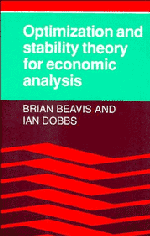Book contents
- Frontmatter
- Contents
- Preface
- 1 CONVEXITY
- 2 STATIC OPTIMIZATION
- 3 EQUILIBRIUM MATHEMATICS
- 4 COMPARATIVE STATICS AND DUALITY
- 5 DYNAMICS AND STABILITY
- 6 INTRODUCTION TO DYNAMIC OPTIMIZATION AND THE CALCULUS OF VARIATIONS
- 7 OPTIMAL CONTROL THEORY
- APPENDICES – MATHEMATICAL REVIEW
- Glossary
- Bibliography
- Author Index
- Subject Index
APPENDICES – MATHEMATICAL REVIEW
Published online by Cambridge University Press: 05 July 2011
- Frontmatter
- Contents
- Preface
- 1 CONVEXITY
- 2 STATIC OPTIMIZATION
- 3 EQUILIBRIUM MATHEMATICS
- 4 COMPARATIVE STATICS AND DUALITY
- 5 DYNAMICS AND STABILITY
- 6 INTRODUCTION TO DYNAMIC OPTIMIZATION AND THE CALCULUS OF VARIATIONS
- 7 OPTIMAL CONTROL THEORY
- APPENDICES – MATHEMATICAL REVIEW
- Glossary
- Bibliography
- Author Index
- Subject Index
Summary
SETS AND MAPPINGS
A set can be regarded as a collection of objects viewed as a single entity. The objects in the collection are called elements or points of the set. If a is an element of set A we write a∈A; a∉A denotes that a is not an element of set A. A set can be defined by listing its elements, A = {1,2,3}, or by stating a common property of its elements; A = {x:x has property P} denotes the set consisting of all objects x that have property P. When two sets A and B have identical elements they are equal, A = B: A ≠ B then denotes that the elements of A and B are not completely identical with each other. A set B is a subset of the set A, denoted B ⊂ A, if for all b∈B, b∈A. Thus, a set is also defined to be a subset of itself. When B ⊂ A and B ≠ A, B is a proper subset of A. Clearly, A = B if, and only if, A ⊂ B and B ⊂ A. The set which contains no elements is called the null or empty set, denoted ø. The null set is a subset of every set. A set can have other sets as its elements. For example, we can consider a set X = {A, B, C} whose elements A, B, C are themselves sets. Here we call X a family of subsets.
- Type
- Chapter
- Information
- Optimisation and Stability Theory for Economic Analysis , pp. 358 - 398Publisher: Cambridge University PressPrint publication year: 1990



